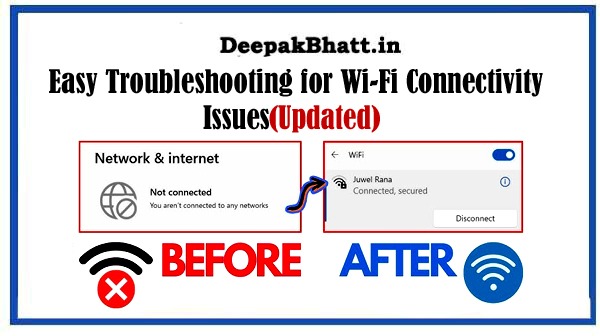Wi-Fi Connectivity Issues can be frustrating, but they’re often straightforward to troubleshoot.
Here are some easy steps you can take to diagnose and fix common Wi-Fi issues:
How to Speed Up Your Computer: Simple Tips
Wi-Fi Connectivity Issues
1. Check Wi-Fi Signal Strength
- Ensure you’re within range of your router. Move closer to the router to see if the signal strength improves.
- If you have multiple Wi-Fi networks available, make sure you’re connected to the correct one.
2. Restart Your Devices
- Turn off your Wi-Fi-enabled device (e.g., laptop, smartphone) and your router.
- Wait for a few minutes, then turn them back on. This simple step can often resolve connectivity issues.
3. Reset Your Router
- Use a pen or paperclip to press and hold the reset button on your router for about 10-15 seconds.
- Release the button and wait for the router to reboot. This will reset the router to its factory settings.
4. Check Network Settings
- Ensure Wi-Fi is enabled on your device.
- Double-check the Wi-Fi password you entered to connect to the network. Make sure it’s correct.
- If using a mobile device, toggle airplane mode on and off to reset network connections.
5. Update Router Firmware
- Access your router’s settings through a web browser (usually by typing the router’s IP address into the address bar).
- Look for a “Firmware Update” or “Software Update” option and follow the instructions to update your router’s firmware. Outdated firmware can cause connectivity issues.
6. Use a Wired Connection
- If possible, connect your device directly to the router using an Ethernet cable. This can help determine if the issue is with the Wi-Fi connection or the device itself.
7. Check for Interference
- Keep electronic devices like cordless phones, microwaves, and Bluetooth devices away from your router, as they can cause interference.
- Consider changing your Wi-Fi channel to reduce interference from neighboring networks. You can usually do this in your router’s settings.
8. Restart Your Modem
- If your modem is separate from your router, unplug it from power for about 30 seconds, then plug it back in. Wait for it to fully restart before testing your Wi-Fi connection again.
9. Contact Your Internet Service Provider (ISP)
- If you’ve tried all the above steps and are still experiencing connectivity issues, contact your ISP for assistance. There may be an outage in your area or a problem with your internet connection that requires professional attention.
By following these easy troubleshooting steps, you can often diagnose and fix Wi-Fi connectivity issues without the need for technical expertise.
If problems persist, don’t hesitate to seek further assistance from your ISP or a professional technician.

















